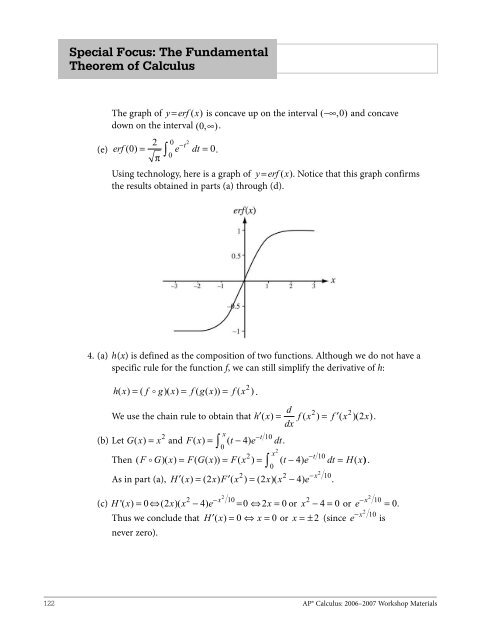AP Calculus
You also want an ePaper? Increase the reach of your titles
YUMPU automatically turns print PDFs into web optimized ePapers that Google loves.
Special Focus: The Fundamental<br />
Theorem of <strong>Calculus</strong><br />
The graph of y = erf ( x) is concave up on the interval ( −∞, 0 ) and concave<br />
down on the interval ( 0, ∞ ).<br />
2 0 2<br />
−t<br />
(e) erf ( 0)<br />
= ∫ e dt = 0.<br />
π<br />
0<br />
Using technology, here is a graph of y = erf ( x). Notice that this graph confirms<br />
the results obtained in parts (a) through (d).<br />
4. (a) h(x) is defined as the composition of two functions. Although we do not have a<br />
specific rule for the function f, we can still simplify the derivative of h:<br />
2 .<br />
h( x) = ( f g)( x) = f ( g( x)) = f ( x )<br />
We use the chain rule to obtain that h′ ( x ) d<br />
= = ′<br />
dx f ( x 2 ) f ( x 2<br />
)( 2 x)<br />
.<br />
(b) Let G( x) = x<br />
2 x −t<br />
10<br />
and F( x) = ∫ ( t − 4)<br />
e dt.<br />
0<br />
x<br />
Then ( F G)( x) = F( G( x)) = F( x 2 2<br />
−<br />
) = ( t − 4) e t 10 dt = H(<br />
x) .<br />
∫<br />
0<br />
2<br />
2 2 − 10<br />
As in part (a), H′ ( x) = ( 2x) F′ ( x ) = ( 2x)( x − 4)<br />
e x<br />
2<br />
2 −x<br />
10<br />
(c) H '( x) = 0⇔( 2x)( x − 4)<br />
e = 0 ⇔ 2x<br />
= 0 or x 2 − 4 = 0 or e x<br />
Thus we conclude that H′ ( x) = 0 ⇔ x = 0 or x = ± 2 (since e x<br />
never zero).<br />
.<br />
− 2 10<br />
=<br />
− 2 10 is<br />
0.<br />
122<br />
<strong>AP</strong>® <strong>Calculus</strong>: 2006–2007 Workshop Materials


